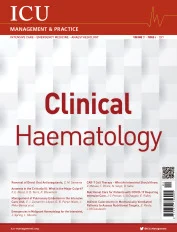
ICU Management & Practice, Volume 21 - Issue 6, 2021
Download PDF |
 |
| PRINT OPTIMISED |
Download PDF |
 |
| SCREEN OPTIMISED |
Editorial
Clinical Haematology
Patients in the intensive care unit frequently report haematological issues. These issues are often a result of critical illness. The most common haematological complications seen in the ICU include thrombocytopenia, anaemia, leukocytosis, thrombocytosis, and coagulopathies. In addition, emergencies in malignant haematology are commonly seen in the ICU and can cause significant mortality and morbidity in c...
Point-of-View
The Importance of Accurate Glucose Monitoring in Critically Ill Patients
The complexity of glucose testing, the limitations of point-of-care blood glucose monitoring systems and the need for accuracy and reliability to ensure optimised patient outcomes. Critically ill patients are not found just in intensive care units, but throughout the hospital: emergency departments, post-anaesthesia care units, operating rooms, and many other environments now care for the critically ill....
Cover Story
Reversal of Direct Oral Anticoagulants
This review focuses on different techniques to reverse direct oral anticoagulants, either with specific or non-specific agents. Direct oral anticoagulants (DOACs) are now standing for Vitamin K antagonists in many clinical settings. They are recognised as a major step forward for our patients. Their efficacy has been confirmed in venous thromboembolism prophylaxis and treatment, in atrial fibrillation a...
Anaemia in the Critically Ill: What is the Major Culprit?
Anaemia is commonly encountered in the critically ill and is associated with poor outcomes. The cause is multifactorial and includes high hepcidin levels and a blunted response to erythropoietin. Anaemia is defined by haemoglobin (Hb) < 12 g/dL for women and Hb below 13 g/dL for men, according to the WHO (1968). Anaemia is a prevalent condition that affects nearly all critically ill patients. Approxima...
Management of Pulmonary Embolism in the Intensive Care Unit
Pulmonary embolism is a reason for admission to the Intensive Care Unit and this complication in hospitalised patients is associated with high morbidity and mortality. The identification and management of pulmonary embolism is a challenge for doctors. Pulmonary Embolism (PE) is the third cardiovascular cause of death since its clinical expressions in critical patients may go unnoticed or present themselve...
Emergencies in Malignant Haematology for the Intensivist
An overview of emergencies that are commonly seen in malignant haematology, side effects of novel therapies, and complications of allogeneic haematologic stem cell transplant. Critical illness is common in patients with haematologic malignancies. Recent data demonstrate that 14% of patients will require ICU admission within one year of their initial diagnosis, with the highest risk in acute leukaemia...
CAR-T Cell Therapy – What An Intensivist Should Know
CAR-T therapy is a promising treatment for B-cell malignancies but is also associated with toxicities such as cytokine release syndrome (CRS) and immune effector cell-associated neurotoxicity syndrome (ICANS). Frequent monitoring, timely recognition and prompt management in ICU are paramount to ensure good outcomes. Chimeric antigen receptor (CAR) T-cell therapy has been hailed as a much-awaited treatmen...
Matrix
Nutritional Care for Patients with COVID-19 Requiring Intensive Care
Recommendations for the management of nutrition of COVID-19 patients provide guidelines for nutrition risk screening, requirements, timing, route and mode of feeding, monitoring, equipment and workforce requirements. The worldwide pandemic of COVID-19 continues to impact all aspects of intensive care unit (ICU) management, including nutritional care (Minnelli et al. 2020). Nutritional guidelines based on e...
Indirect Calorimetry in Mechanically Ventilated Patients to Assess Nutritional Targets
An overview of the physiological aspects of indirect calorimetry, its limitations in use, the available literature and future prospects for tailored nutrition. Medical nutrition therapy (MNT) is an essential part of patient care in the intensive care unit (ICU) setting. Similar to mechanical ventilation and haemodynamic management, nutritional intake should be individualised for each patient. Achieving e...
DigiConf
Clinical Haematology Digital Conference
Join our panellists on November 30 at 16:00 CET as they discuss coagulation, anaemia, haematological malignancy, and other important presentations of haematological disease in critical care. Register here! Moderator Jean-Louis Vincent Editor-in-Chief ICU Management & Practice Professor Department of Intensive Care Erasme Hospital Université libre de Bruxelles Brussels, Belgium Panellists Charles...
Agenda
Agenda
DECEMBER 1-3 DIVI 2021 - German Interdisciplinary Association for Intensive Care and Emergency Medicine Congress Virtual event https://iii.hm/1dcs 5-8 Critical Care Canada Forum 2021 Virtual event https://iii.hm/1dct 6-8 ICS State of the Art 2021 Virtual event https://iii.hm/1dcu 17-19 Euroanaesthesia 2021 Virtual event https://iii.hm/1dcv 2022JANUARY 3-7 Blood Diseases in the ICU: Advance Training...
Annual Index
ICU Management & Practice 2021 Subject Index
Issues/ Pages Volume 21, Issue 1 1-60 https://iii.hm/17iz Volume 21, Issue 2 61-116 https://iii.hm/18zj Volume 21, Issue 3 117-168 https://iii.hm/1afx Volume 21, Issue 4 169-202 https://iii.hm/1bky Volume 21, Issue 5 203-249 https://iii.hm/1c7q Volume 21, Issue 6 250-302 https://iii.hm/1d8s Subject index Airway Management Karamchandani K, Khanna AK, Myatra SN. Airway Management in Critically Ill Pat...
ICU Management & Practice 2021 Author Index
Aarab Y 20 https://iii.hm/17j3, 162 https://iii.hm/1agk Allen J 52 https://iii.hm/17jm Artigas A 70 https://iii.hm/18so, 174 https://iii.hm/1bk3, 176 https://iii.hm/1bk5 Banner-Goodspeed V 93 https://iii.hm/18sw Bautista-Aguilar GA 229 https://iii.hm/1c8b Begos D 76 https://iii.hm/18sy, 266 https://iii.hm/1d99 Bellani G 142 https://iii.hm/1aga Besen BP 240 https://iii.hm/1c93 Bhowmick K 262 https://iii....



















